
// BBS Art
BBS ART is comprised of many different mediums that
can be transmitted through dial-up or telnet communication. The most common BBS ART is
textmode art (ANSI/ASCII). You can view some of the best ANSI/ASCII artwork that has spanned for more then two decades on
the Sixteen Colors website.
// ANSI and ASCII
ANSI art is an improved form of ASCII art,
and it is constructed from an expansive set of 256 characters, including
letters, numbers, and systems that are found in the IBM Code Page 437.
These characters, which allow for the representation of shapes and patterns,
are also known as the extended ASCII and are used in MS-DOS and Unix
environments. ANSI art is also distinguished by its use of special ANSI
escape sequences (or “ANSI escape codes”) that color text with the 16
foreground and 8 background colors offered by ANSI.SYS
(pronounced an-see-dot-siss), a DOS device driver. ANSI art and text
files that incorporate ANSI codes carry the .ANS file extension.
ASCII art is essentially images created only through text characters. ASCII (pronounced ask-ee) includes a set of 128 characters, and the art utilizes control characters and graphic characters, such as letters, digits, and symbols. While ultimately tracing its origins to text-based art delivered though typewriters, ASCII thrived as the visual language of pre-WWW networks like BBSs and Telnet.
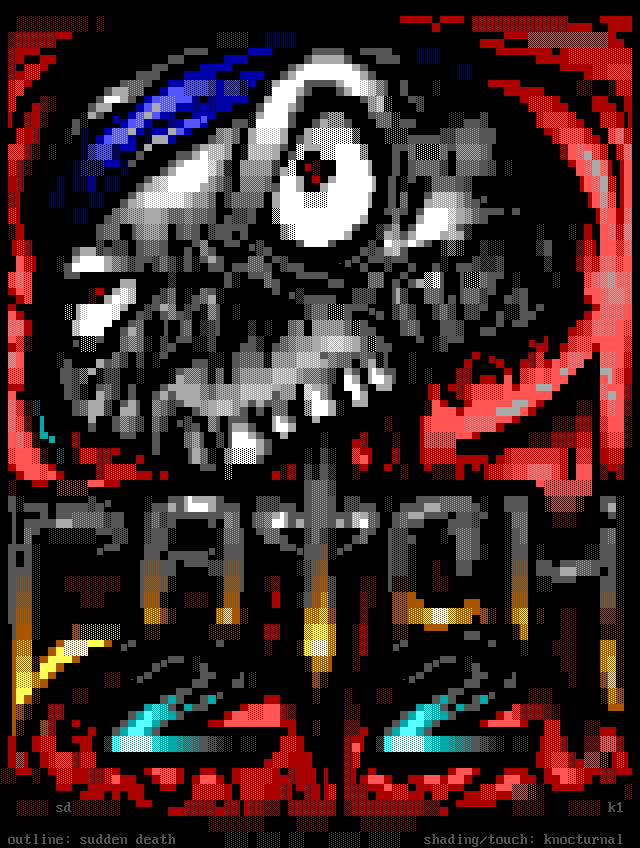
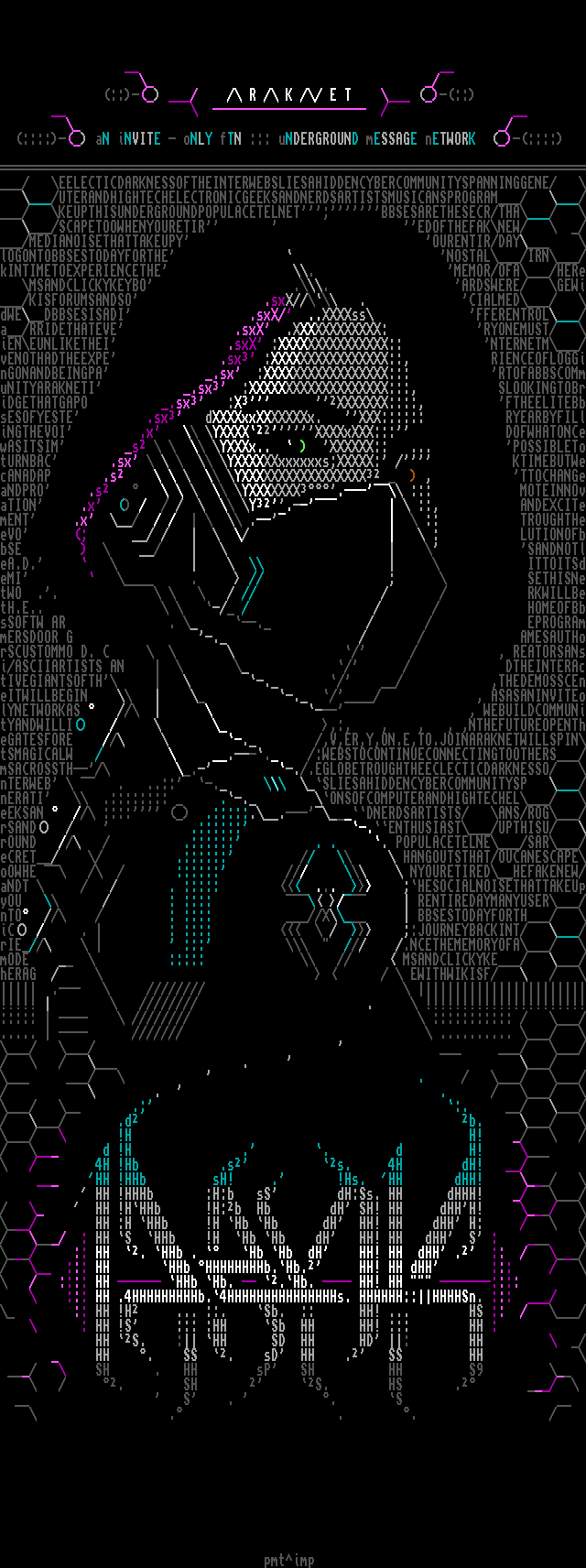
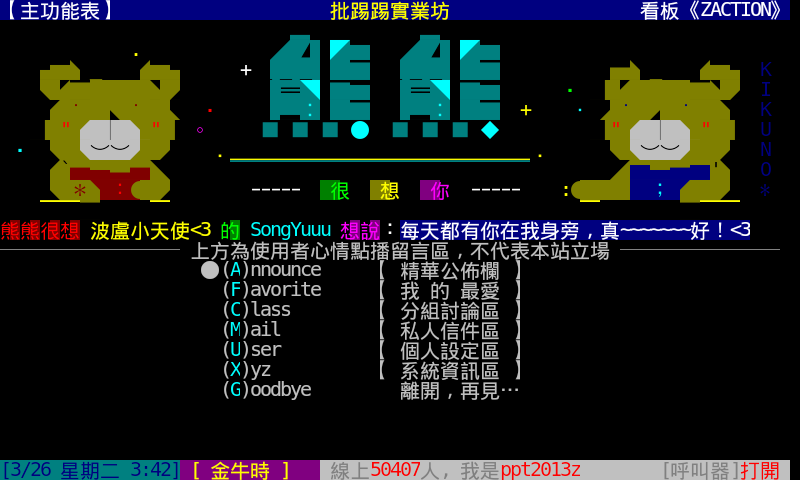
ANSI/ASCII (Modern) Editors:
ANSI/ASCII (LEGACY) Editors:
ASCII art is essentially images created only through text characters. ASCII (pronounced ask-ee) includes a set of 128 characters, and the art utilizes control characters and graphic characters, such as letters, digits, and symbols. While ultimately tracing its origins to text-based art delivered though typewriters, ASCII thrived as the visual language of pre-WWW networks like BBSs and Telnet.

Catch 22 BBS (ANSI)- by Knockturnal<Blocktronics> and Sudden Death<CiA>

ArakNet Promo (ASCII)- by Prismate<iMPURE>

Example of Unicode ANSI - Example: Taiwanese BBS Menu
ANSI/ASCII (Modern) Editors:
- DurDraw - ASCII and Unicode drawing and animation program for UNIX (https://github.com/cmang/durdraw)
- Moebius ANSI Art Editor (https://blocktronics.github.com/moebius/)
- Moebius ANSI Art Editor w/custom font support (https://is.gd/PXBqlG)
- Moebius ANSI Art Editor w/custom font/xtended palette support (https://github.com/hlotvonen/moebius/releases/)
- PabloDraw ANSI Art Editor (http://picoe.ca/products/pablodraw/)
- Necro's unofficial Pablodraw builds (https://fuel.wtf/pablodraw/)
ANSI/ASCII (LEGACY) Editors:
- TheDraw 4.63 (DOS)
- TheDraw 5.0 (DOS)
- ACiDDraw v1.25 (DOS)
- Artworx v0.91a (DOS)
- Empathy Textmode Screen Editor v1.00p (DOS)
- iCEDraw v1.40 by Necros<ICE> (DOS)
- TundraDraw v.5b1 (WIN)
- TundraDraw v.5b1 (LINUX-deb)
- TundraDraw v.5b1 (LINUX-rpm)
- CiADraw v.8 (DOS)
- Mistigris PabloDraw v0.971 (DOS)
- DarkDraw v.72alpha (DOS)
- iTPDraw v0.20beta (DOS)
- AMPro ANSINator v2.10 (DOS)
// PETSCII
The character set was largely designed by Leonard
Tramiel (the son of Commodore CEO Jack Tramiel) and PET designer Chuck Peddle. The
graphic characters of PETSCII were one of the extensions Commodore specified for
Commodore BASIC when laying out desired changes to Microsoft's existing 6502 BASIC
to Microsoft's Ric Weiland in 1977. The VIC-20 used the same pixel-for-pixel font as
the PET, although the characters appeared wider due to the VIC's 22-column screen.
The Commodore 64, however, used a slightly re-designed, heavy upper-case font,
essentially a thicker version of the PET's, in order to avoid color artifacts
created by the machine's higher resolution screen. The C64's lowercase characters
are identical to the lowercase characters in the Atari 800's system font (released
several years earlier).
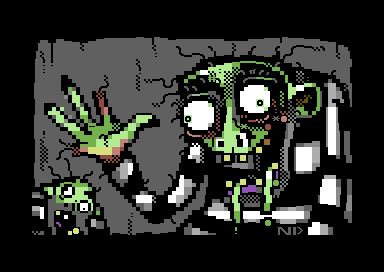
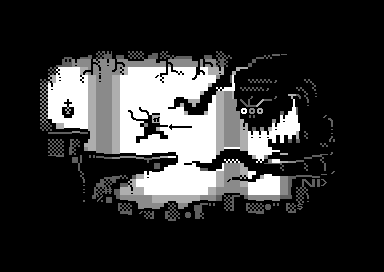
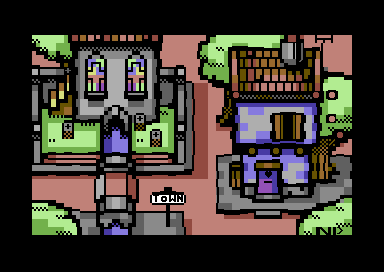
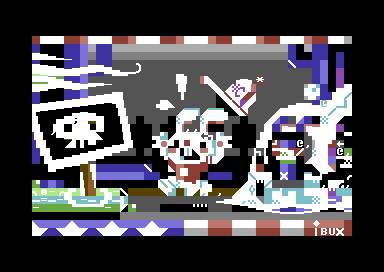
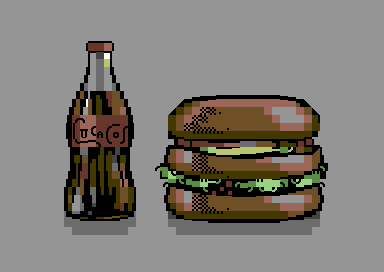
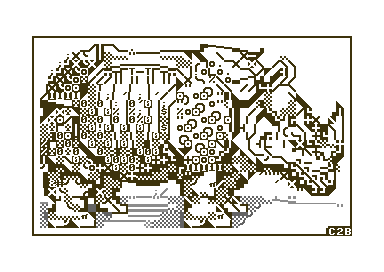
PETSCII Art Editor:






PETSCII Art Editor:
- Petmate - C64 Editor (Win/Mac/Linux) (https://nurpax.github.io/petmate/)
- Marq's PETSCII Editor (http://www.kameli.net/marq/?page_id=2717)
- Online PETSCII Editor (https://petscii.krissz.hu/)
// RIP
The Remote Imaging Protocol and its
associated Remote Imaging Protocol Script language, RIPscrip, is a graphics
language that provides a system for sending vector graphics over low-bandwidth
links, notably modems. It was originally created by Jeff Reeder, Jim Bergman,
and Mark Hayton of TeleGrafix Communications in Huntington Beach, California to
enhance bulletin board systems and other applications.
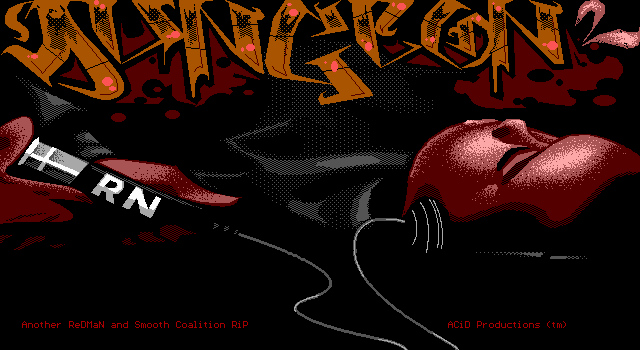
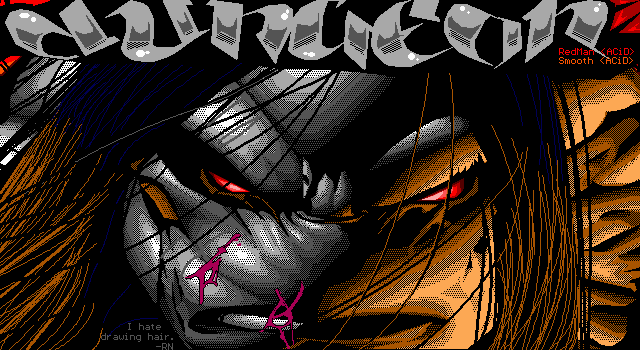
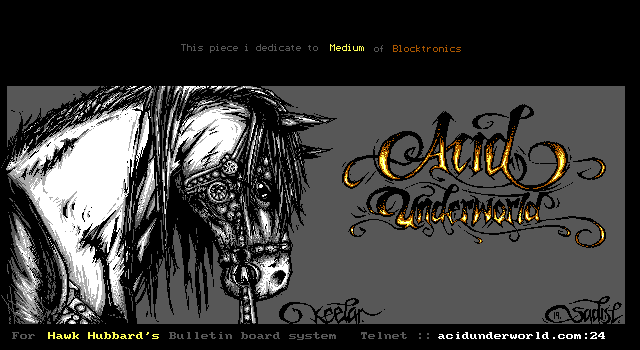
RIP Art Programs:

Dungeon 2 BBS (RIP) - by RedMan<ACiD> and Smooth<ACiD>

Dungeon BBS (RIP) - by RedMan<ACiD> and Smooth<ACiD>

Dungeon BBS (RIP) - by Keetar<Blocktronics>
RIP Art Programs:
